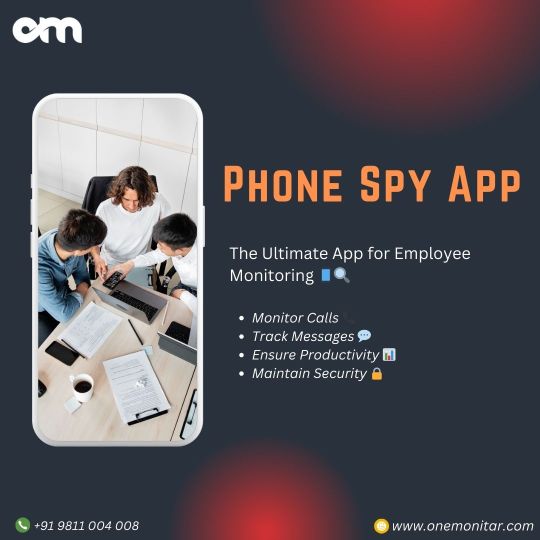#Workforce tracking software
Explore tagged Tumblr posts
Text
OneMonitar: Empowering Workplace Oversight

Unlock comprehensive employee monitoring with OneMonitar. Monitor calls, track messages, ensure productivity, maintain security, and utilize GPS tracking. Enhance workplace efficiency and accountability effortlessly.
#Employee surveillance tool#Workforce tracking software#Staff supervision application#Workplace behavior analysis platform#Team activity monitoring solution#Personnel performance management tool
0 notes
Text
0 notes
Text
#HRMS Software#Workforce Management & Payroll Solutions#Employee Timesheet Software#Attendance & Payroll HRMS Solutions#HRMS Management#Enterprise Resource & Staff Time Tracking Software#software#crm software#attendance management software#payroll
1 note
·
View note
Text
Enhancing Healthcare Services with Imprint – A Smart Field Force Management SolutionAsti Infotech’s healthcare-focused solution, Imprint, is a comprehensive field force management system designed to meet the unique needs of the healthcare industry. It ensures seamless coordination, real-time monitoring, and efficient task allocation for healthcare professionals working in the field. Whether it's home healthcare providers, diagnostic service teams, nursing staff, or hospice caregivers, Imprint helps streamline operations and improve service quality. With features like live tracking, automated attendance, route optimization, and real-time reporting, Imprint empowers healthcare organizations to enhance productivity while ensuring timely patient care. Managers can assign tasks based on location and availability, reducing delays and improving response time. The system also ensures transparency and accountability with detailed logs and activity records. Imprint not only reduces operational inefficiencies but also boosts patient satisfaction by ensuring reliable and prompt care delivery. The solution is mobile-friendly and easy to use, making it ideal for healthcare staff constantly on the move. By leveraging Imprint, healthcare providers can focus more on patient outcomes while the system handles workforce logistics. It’s a powerful tool for organizations aiming to scale their services and maintain high-quality standards across their operations.
#Healthcare field force management#Healthcare workforce tracking#Home healthcare management software#Field staff monitoring system#Healthcare task management solution#Real-time healthcare staff tracking#Imprint healthcare solution#Mobile workforce management for healthcare
0 notes
Text
lov111vol
LOV111VOL is a modern application that effectively replaces employee time tracking registration in your company. It works 50 seconds after downloading and offers the same features as traditional employee time tracking registration, plus many other useful tools. With LOV111VOL, employee working hours are precisely recorded and managed, making processes in the company simpler and more efficient. The application is suitable for both individual and team work, supporting digital management of employee working hours.
#employee time tracking#work hours tracker#attendance management system#timesheet software#workforce scheduling tool
1 note
·
View note
Text
Get a field force management software that will optimize your sales team performance anywhere and anytime.
#Field Force Management Software#Field Force Management#Field Team#Field Team Tracking#Team Tracking#Workforce Management#Real-Time Location Tracking#Employee Tracking Software
0 notes
Text
#ERP solution for contractors#Contractor management software#Construction ERP software#All-in-one ERP for contractors#Best ERP for construction industry#Project management ERP for contractors#Contractor operations software#ERP for general contractors#ERP for specialty contractors#Streamlining contractor operations#Best ERP software for construction contractors#ERP for managing contractor bids and projects#Cloud-based ERP for construction industry#How to streamline contractor operations with ERP#ERP solution for efficient project management#Contractor job tracking software#Financial management ERP for contractors#AI-powered ERP for contractors#Real-time project tracking ERP#Contractor workforce management ERP
1 note
·
View note
Text
0 notes
Text
Streamlined Time and Attendance Management for Enhanced Workforce Efficiency
Effective time and attendance management is crucial for maintaining workforce productivity and compliance. Advanced systems leverage technology like biometric devices, mobile apps, and cloud-based platforms to track employee work hours accurately. These tools provide real-time data on attendance, overtime, and leave, ensuring seamless payroll integration and better workforce planning. Businesses can minimize errors, enhance efficiency, and focus on strategic growth by automating attendance processes.
More info: https://ahalts.com/solutions/hr-services/outsourcing-time-attendance

#Time and Attendance Management#Biometric Attendance#Employee Time Tracking#Attendance Software#Workforce Productivity#Leave Management#Work Hours Monitoring#Automated Attendance System#Real-Time Tracking#HR Solutions
0 notes
Text
1 note
·
View note
Text
How VMS, Vendor Management Systems, and Direct Sourcing Work Together

By integrating a VMS for contingent workforce management, vendor management systems, and direct sourcing, companies can create a seamless and effective workforce strategy.
Enhanced Flexibility: A VMS and direct sourcing provide options for both contingent and direct-hire needs, allowing businesses to remain agile and responsive.
Cost Optimization: Vendor management and direct sourcing reduce dependency on high-cost staffing agencies, creating a more budget-friendly approach to talent acquisition.
Comprehensive Compliance: Together, these solutions ensure regulatory adherence, minimizing risks and enhancing accountability.
Data-Driven Decision Making: With real-time data across all platforms, companies can assess performance, spending, and hiring needs effectively.
Conclusion
For organizations aiming to streamline workforce management, combining a VMS contingent workforce, a structured Vendor Management System, and strategic Direct Sourcing is a game-changer. These solutions not only improve efficiency and flexibility but also provide insights and control that drive workforce strategy and success. In today’s fast-paced market, this comprehensive approach equips businesses with the agility and resilience needed for sustainable growth and competitive advantage.
We hope you found this blog helpful. Here are some additional resources you might want to read:
How to Automate Vendor Invoice Management?
Top 10 Vendor Management Best Practices for Every Business
Top 25 Strategic Thinking Interview Questions to Ask Candidates
#contingentworkforce#vendor management software#vendor management solutions#directsourcing#vendormanagement#procurement#talentacquisition#vendor management tools#applicant tracking system#vms contingent workforce#vms provider#vms platform#vms management#what is a vms#VMS system#Vendor Management Solutions
0 notes
Text
Managing large teams—whether employees, field staff, or volunteers—is no easy feat. Organizations often struggle with last-minute shift changes, attendance discrepancies, and inefficient scheduling, leading to lost productivity and unnecessary administrative burden. Without a structured system in place, businesses find themselves constantly firefighting, dealing with absenteeism, compliance issues, and overworked teams.
Workforce Automation Software to Cut Scheduling Time by 50% | Imprint
#Workforce Automation#Field Force Automation#Field Workforce Management#Employee Tracking Software#Mobile Workforce Solutions#Imprint Software
0 notes
Text
Elevate Your Business with Cloud Workforce Management Software Services

Cloud Workforce Management Software Services provide businesses with a suite of tools to manage their workforce efficiently through a cloud-based platform. These services help streamline tasks such as employee scheduling, attendance tracking, payroll, and performance management, all accessible remotely, offering flexibility for both in-office and remote teams.
#cloud workforce management software services#best Cloud Based Workforce Management Software#best Workforce Management Software For Cloud usa#KPI Tracking and Strategic Planning#Kpi For Strategic Planning Performance#Kpi For Strategic Planning#Kpi Tracking Software For Business#strategic planning software for business kpi#business planning software cloud workforce services#usa
1 note
·
View note
Text
The Role of Liveness Detection in Modern Time & Attendance Systems

In today's fast-paced and ever-evolving workplace, accurate attendance tracking is crucial for effective workforce management. Traditional methods, such as manual timekeeping and basic biometric systems, often struggle with vulnerabilities that can lead to time fraud and inaccuracies. Enter liveness detection technology—a game-changing solution that is transforming how organizations monitor employee attendance and ensuring the integrity of their workforce data.
What is Liveness Detection Technology?
Liveness detection is a sophisticated biometric solution designed to verify that the individual attempting to log their attendance is physically present. This technology distinguishes between real faces and potential spoofing attempts, such as photographs, videos, or masks, by analyzing various facial features and behaviors. Liveness detection employs advanced algorithms that evaluate subtle micro-movements, like blinking, smiling, and facial texture, to confirm that the person is alive and genuinely present.
The use of artificial intelligence (AI) and machine learning enhances the accuracy of liveness detection, enabling systems to perform real-time assessments. This ensures that attendance tracking is not only secure but also reliable.
Enhancing Traditional Attendance Systems
1. Eliminating Time Fraud
One of the most significant advantages of liveness detection is its ability to eliminate time fraud—a common issue in workplaces where practices like buddy punching are prevalent. Traditional biometric systems, such as fingerprint scanners or RFID cards, can be easily manipulated, allowing one employee to clock in for another. Liveness detection addresses this vulnerability by ensuring that only live individuals can mark their attendance.
By verifying the presence of a live person, organizations can safeguard attendance records and protect themselves from financial losses associated with inflated work hours.
2. Improving Accuracy and Reliability
Liveness detection significantly enhances the accuracy and reliability of attendance tracking. Traditional systems may suffer from technical issues or user manipulation, but liveness detection captures data in real time, ensuring that attendance logs are updated instantly. This level of precision eliminates ambiguities and delays, providing organizations with reliable data to make informed decisions about scheduling and resource allocation.
3. Streamlining User Experience
Integrating liveness detection into attendance systems also improves the user experience. Employees can log their attendance quickly and efficiently without the need for physical interaction with outdated systems. This ease of use is particularly important in today’s contactless work environments, where health and safety are paramount. Employees benefit from a seamless process that respects their time while maintaining security.
4. Fostering Accountability and Integrity
The incorporation of liveness detection promotes a culture of accountability within the workforce. By ensuring that attendance records reflect genuine employee presence, organizations foster trust and transparency among team members. This integrity is essential for effective workforce management and can contribute to improved morale and productivity.
Conclusion
In conclusion, liveness detection technology is redefining modern time and attendance systems, making them more secure, accurate, and user-friendly. By reducing the risk of fraud and enhancing the accuracy of attendance records, liveness detection not only boosts operational integrity but also fosters a culture of accountability within the workforce.
As organizations increasingly adopt advanced technologies, the integration of liveness detection into attendance systems represents a significant advancement in ensuring genuine employee presence. Embracing this innovative technology allows organizations to ensure reliable attendance tracking, reduce fraud, and ultimately enhance their overall workforce management strategies.
Discover the Future of Attendance Management
Organizations looking to stay ahead in today's competitive landscape should consider integrating liveness detection technology into their attendance systems. By leveraging this cutting-edge solution, businesses can streamline their operations, enhance security, and promote accountability, setting the stage for a more efficient and effective workforce management.
#systellar technologies#time and attendance system#liveness detection technology#attendance system#face liveness detection#bioemtrics#technology#future technology#workforce management system#praesentia#time tracking software#AI
1 note
·
View note
Text
#Time Tracker#Time Tracking#Time Tracking Software#time tracking tool#time management#employee productivity#Workforce Engagement#Workforce Engagement Management#WEM#Time
0 notes
Text
Top Time Tracking Software to Boost Productivity

Ever feel like there just aren't enough hours in the day? You're not alone. We all juggle overflowing to-do lists, and sometimes, it's hard to pinpoint where our precious time is going. Enter the magic of time tracking software.
These handy tools are like productivity superheroes, helping you understand how you spend your work hours and become a time management master. But with so many options out there, choosing the right one can feel overwhelming. Fear not, fellow warriors against the clock! This comprehensive guide unveils the top time tracking software to elevate your productivity and conquer your workday.
Clockify: The rockstar of all-around time tracking, Clockify offers a free plan with unlimited users and projects – perfect for individuals or small teams. It's easy to use, integrates with popular apps, and provides insightful reports to help you identify timewasters.
Quick Books Time: Calling all mobile warriors! Quick Books Time is a fantastic option for teams with a lot of on-the-go activity. Their mobile app is top-notch, making it a breeze to track time from anywhere. Plus, it integrates seamlessly with other QuickBooks products.
Time Camp: Freelancers, rejoice! Time Camp is built specifically for you, offering features like invoicing and automatic time tracking. It also boasts robust reporting tools, so you can show clients exactly how you're crushing their projects.
Deputy: Keeping track of employee hours can be a headache, especially when compliance comes into play. Deputy steps in as your guardian angel of employee time management software. It ensures you're adhering to labor laws and simplifies payroll processing.
IdioTime: Managing a small or large team!! Idiotime can help you manage your team effectively for workforce planning and resource management. With this employee time tracking application, you can easily boost your organization's productivity.
Toggl Track: Looking for a simple and free time tracking solution? Toggl Track might be your perfect match. Their free plan offers basic tracking features, making it a great option for individuals or small teams just starting out.
Tracking Time: Managing a small team can be tricky. Tracking Time comes to the rescue with its user-friendly interface and features designed specifically for collaborative time tracking. It's easy for teams to keep projects on track and identify areas for improvement.
Time Doctor: Need to keep your remote team accountable? Time Doctor offers a unique approach with features like website and application monitoring. It's important to use such tools with transparency and open communication, but they can be helpful for ensuring everyone's focused.
Rescue Time: Do you ever feel like you spend all day staring at your computer, but nothing gets done? Rescue Time is a productivity ninja in disguise. It automatically tracks your activity throughout the day and provides insightful reports on where your time goes. Identify those social media rabbit holes and reclaim your focus!
monday.com: This project management powerhouse also offers excellent time tracking features. It's a great option for teams who already use monday.com to keep everything organized in one central location.
Connecteam: This all-in-one solution caters specifically to the needs of mobile teams. It combines time tracking with features like scheduling, communication, and task management, making it a great choice for businesses with a highly mobile workforce.
The best time tracking software is the one that fits your specific needs and workflow. Consider factors like team size, budget, desired features, and mobile access. Don't be afraid to take advantage of free trials to see which software feels most intuitive for you. Remember, time tracking software is an investment in your productivity – and your sanity! So, take control of your time and watch your accomplishments soar.
--------------------------------------------------
Why is time tracking important for productivity?
It helps identify time-wasting activities, streamline workflows, and improve time management.
What are some popular time tracking software options?
Popular options include Clockify, Quick Books Time, Idiotime, Time Camp, Toggl Track etc.
What should I consider when choosing time tracking software?
Consider ease of use, features, cost, and compatibility with existing systems.
Is time tracking software secure?
Reputable time tracking tools use encryption and other security measures to protect data.
How can I ensure my data is secure when using time tracking software?
Choose a trusted provider, use strong passwords, and regularly update the software.
How does time tracking software benefit remote teams?
It helps monitor productivity, ensure accountability, and manage time effectively across different locations.
Is time tracking software scalable?
Yes, most time tracking tools can accommodate growing teams and increasing project complexity.
--------------------------------------------------
0 notes